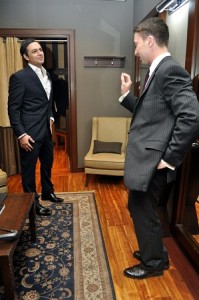
He describes his six-month stint as a Unesco consultant in the beleaguered West Bank in Palestine as “loads of fun,” so you can tell that Leif-Erik Hannikainen can deftly handle any corpulent client who insists on dressing like Carrie Bradshaw for the Polo Club ball.
Erik, 32, is a personal shopper at Rustan’s Makati, a job that demands utmost discretion and diplomacy if he is to gently steer his coiffured clients from tacky to tasteful. With three generations of diplomats in his family, including his father, Finnish Ambassador Heikki Hannikainen, it seems like a perfect match. Erik grew up traveling and absorbing the nuances of “No,” “Maybe” and “We’ll see” from many cultures and skillfully applies them to the job.
A good personal shopper, he says, must not only know the product very well, but must also know how to listen to clients to find out what they’re really like and how best to match them with what’s available. The main goal, he adds, is to make clients look good. So how does he deal with shoppers who whip out a catalog and demand that he help them get the model’s look even without the build for it?
“I try to see something good in their choices and gently lead them away from extremes,” he says blithely. “Let’s say they like very bright colors that make them look like a clown. I say, hmm, what if you wear a dark coat and we’ll just put a spot of color here, or here? That will work, right?”
But women shoppers, he reveals, already know what they want and only half of them really listen to advice. “So if they insist, I give them tips to minimize the damage. I do damage control. I say, be sure to wear dark colors with that to further slim you down. Or I tell them, make sure everything is in proportion. Wear very quiet shoes, keep accessories to a minimum.
“I try to be discreet. I blame a third party to hide my reservations about their choices. If, say, an elderly woman wants to wear a revealing gown, I’ll say, be sure to wear a shawl with that because the evenings can get too cold. Or I say to another who wants to wear tight cowboy pants, oh, but you might get too hot because there will be lots of dancing. Wouldn’t something chiffony work better? I blame the weather, the air con, the heat, the dancing, the clothing material, and so on.”
Another slippery slope is the slew of superstitions that still hound some of the more cosmopolitan shoppers. “Color can be tricky especially if the client is of Chinese descent,” Erik notes. “It’s very difficult to sell some clients black cocktail dresses. They won’t wear the LBD (little black dress) to weddings or birthday parties, for instance, or any dress that is somehow connected to the number 4, or wear white or too much red for certain occasions.”
Otherwise, he feels confident enough about fashion to invite the social set and the expats he meets in the diplomatic circle to come over and see the shop’s latest collection. Says Val Khodaverdi, Rustan’s VP for Store Operations: “Erik is like an oracle. He knows everything you need to know about fashion.”
His intest in clothes and fashion is something that he developed through a most circuituous route: via Byzantine history. Erik holds a degree in History and a Masters in Byzantine History from Oriel College in Oxford, England. “Everything is grounded in history,” he says. “History gives you a good grasp of current events and foreign relations because most things that happen now have happened before. If you know your history, you’d also know fashion,” he laughs.
The perfect link between fashion and history he found in Beau Brummel, the historical figure he most admires. “In 1810 in England, he was the favorite in the Court of the Prince Regent,” he says. “He wrote down the do’s and don’ts of men’s fashion. He was a horrible person but a terrific fashion arbiter. Very well dressed and discreet, he toned down men’s clothing in England from bright colors to the dark coat.”
Erik’s tastes in clothes are similarly low-key. “I like seersucker and pastel colors. I’m very preppy. At home, I wear chinos, linen trousers, topsiders or boat shoes. No flip-flops for me. Flip-flops are for the beach.”
He finds baggy shirts and shorts “really horrendous,” and wouldn’t be caught dead in public wearing them. He adds: “Wearing Birkenstocks, unless specifically ordered by one’s orthopedic doctor, and baggy clothing should be considered a hanging offense. They should bring back the Inquisition for that. Everyone has a certain body size or shape and should stick to it. Wear clothes that fit the body.” Board shorts are similarly anathema to him, he says. “Informal and trendy should never be used in the same sentence. So the weather’s hot? Deal with it!”
He may be young but he’s definitely an old soul: “I love art deco, you know from the 1930s: severe lines, geometrics, everything in order, so very square,” he says and cites the alabaster bar at the entrance of Opus at Resorts World Manila as being “very art deco.”
One year on the job and three years in the Philippines have given Erik enough insights about the shopping habits of Filipinos. “They don’t buy quite as many shoes as I originally thought,” he says, laughing. “But of course everybody knows about Imelda,” he explains.
Filipino women like long dresses, gowns or formal frocks, he observes. “They’re very fashion savvy and know what they like. They’re very familiar with American fashion, but are trending towards European fashion, meaning tailored, with a better fit.”
There are a lot of fashionable women in the country, he says but if he were to name his five best-dressed, they would be top model Karen Pamintuan, chef Stephanie Zubiri, beauty queen Maggie Wilson “who looks amazing even when she’s very pregnant,” celebrity painter Betsy Westendorp, and high society figure Tessa Prieto Valdes, “because she makes clothes look so much fun. She makes me smile and feel happy when she walks into the room.”
As for Filipino men, they are a bit scared of color, says Erik. “I want them to wear more linen suits and more colors. I look at photos of Manila in the 1930s and the men look so elegant. Young Filipino men these days are more adventurous, but wearing fitted clothes is the way to go.”
A lot of fashion today, he adds, is influenced by TV and the media, like the TV series “Mad Men” or “Pan Am” which has resulted in better dressing. “One really feels better and happier if one is well dressed.”
HE’S such a geek in school, recounts Erik, and he just loves James Julius Norwich, “who wrote more than a thousand pages on the Crusades and the Byzantine period.” But it is his mother who may have exerted the biggest influence on his tastes and interests. Italian Baroness Eleonora de Strobel di Fratta e Campocigno has a reputation for being a fantastic hostess who’s always had good cooks and this must have inspired her son to venture into cooking as well.

“I love to cook,” says Erik. “I’m not very good, but I’m improving. You know how it is—with cooking, if anything goes wrong, it’s a disaster. Otherwise, it’s like the Creation! Sometimes I even manage to surprise myself with food that comes out as quite edible.” She is very supportive of him, he says of his mother. He remembers starting on his job as a personal shopper with hardly any training. “I was just thrown into the deep end,” he says dramatically. So using what he describes as “emotional blackmail,” he enlisted his mother and Silvana Fornari, the wife of the Italian ambassador, as clients on his first day on the job to give him support.
The diplomatic circle is just as cozy, he says. “There are just three degrees of separation among old friends in the diplomatic circle despite the constant travel and reassignment. I find that very comforting.” But no, he’d rather not get into the family business. “The world is changing and diplomacy now is more about business so I’ve decided to do something different.”
Apparently, so did his siblings. Brother Kristian is a musician while sister Diana, the eldest, is an astro physicist. “She studies the birth and death of stars but I don’t understand a word of what she’s doing,” Erik shrugs.
MOST shoppers who need shopping advice just ask for Erik, or Miss V., the other Rustan’s personal shopper. Today, he is assisting furniture and interiors designer Assi Deri who wants to shop for clothes.
Erik starts to lead the way to the Men’s department at the ground floor, but remembers something. “Oh wait, let’s have some coffee first so I can show you the latest coffeemakers we have.” Over cups of espresso, he explains the merits of two high-end brands to Assi, discussing ease of use and cleaning, design and colors, as well as price. Up to P180,000 for an Italian brand, it turns out.
Over the next hour, Erik encourages the shopper to try on clothes from several name brands (like Hackett of London), shows him the store’s exclusive dressing rooms, and keeps a constant prattle on the whys, wherefores and hows of particular pieces of apparel. “The four buttons in front makes it easy for the men to poke their heads through the shirt and get on with the rowing competition…” “No, no, that’s too tight for you.” “Do these come in other colors?” he queries a sales assistant.
His client is as voluble perhaps because they’re old friends. He looks over at the full-length mirror at the pinstripe suit that Erik has asked him to fit. “Hmm, I look like a banker, and they’re not very popular at the moment,” he complains. “That’s not your color, try something darker,” Erik responds. In between fittings, the two men quietly discuss previous and upcoming outings, the wifey, the kids. “Do you think they have another color for this,” Assi asks, eyeing a vintage toy jeepney that he wants for his son. Erik promptly picks it up to ask the sales staff.
He is as helpful to other clients, usually asking them probing questions to pin down the most appropriate gift: “What’s the occasion? What’s your budget? What’s the recipient like? How are you related (by blood or marriage)? How much do you like this person?”
“If it’s the husband sending his secretary over for his wife’s gift, I usually ask: does she smoke? Is she sporty? Does she read books? Does she throw a lot of parties? Because you know, you can never have enough silverware.”
Back at the fitting room, the shopping/consultation is winding down and the sales staff is collecting the clothes and returning them to hangers. Assi makes ready to go. He’s not buying anything? “No, I don’t buy stuff right away,” he says. “I need a second opinion, so I usually ask my wife to come and see what I like. I sleep on it and come back later. Unless it’s a perfect fit.”
That’s alright, says Erik. “My job is to show clients what’s available and allow them to make up their mind. I let them breathe. Nothing is worse than high pressure selling. You can get an ashtray and break it accidentally, but when it comes to clothes—which can cost a lot if they’re of good quality—you can feel guilty if you don’t use them. And you can’t just give them away either because of the different sizes and tastes. So shoppers have to think very hard and take their time before buying clothes. We don’t mind.”
Seeing all that luxury collection all the time, doesn’t he get tempted to stock up on the goodies as well? “Nope,” Erik says briskly. “I just think, they’re really nice and someday I’ll have them.”
But, he adds, if he has lots of money, he’d draw up his own shopping list. And on it would be? “Clothes, shoes, cufflinks, anything in old ethnographic prints, old knick knacks that I mix and match, classic and dark colors like a cigar for warmth.” He hesitates then plunges on. “But I’m not buying too much. I’m trying to be fiscally responsible. I want to go to Burma.” •
The Right Stuff
A gift-giving guide from a Personal Shopper
• People tend to give gifts that they like personally. But remember, not everybody likes what you like.
• Think of people’s hobbies and little gadgets that go with them.
• Give little presents in a set and wrap them individually. It heightens the anticipation.
• For children, give stuff that will get them moving and away from the computer and hi-tech gadgets if only for a while. Think of something educational or sporty, something that will keep them involved, like board games based on their interest or on the shows they like. There’s a mini-Project Runway toy in the 3rd floor, with small scissors, for instance, that little girls might like.
• As for budget or cost, don’t embarrass the recipient by being too lavish, or embarrass yourself by being niggardly. Use your relationship with the recipient as a guide.
• When it comes to gifts for the boss, don’t be too extravagant. You’re skating on thin ice here. From my point of view, this smacks of bribery and might put you in a difficult situation with your colleagues. But if you must, get something really fun and simple, something for their hobby.
• If you must recycle gifts, remember who gave them to you!
• Food is always a safe choice, but give something they really like.
• Unless it’s really, really good fruit cake, give rum cake instead.
• When it comes to gifts, the recipient has to like it; it’s not the cost that matters.
Most expensive items a client has bought:
“A christening gift from Tiffany’s for P8,000 to P9,000, a tie from Ferragamo for P6,000. I once suggested a Cartier clock for P42,000, but the client has yet to get it.”
Most popular gift item for Christmas: “These little dishes from the Home Dept. that people fill with cookies and give to their neighbors.”
Most expensive thing you’ve bought for yourself: “Swimming trunks that cost P7,000.”.












































